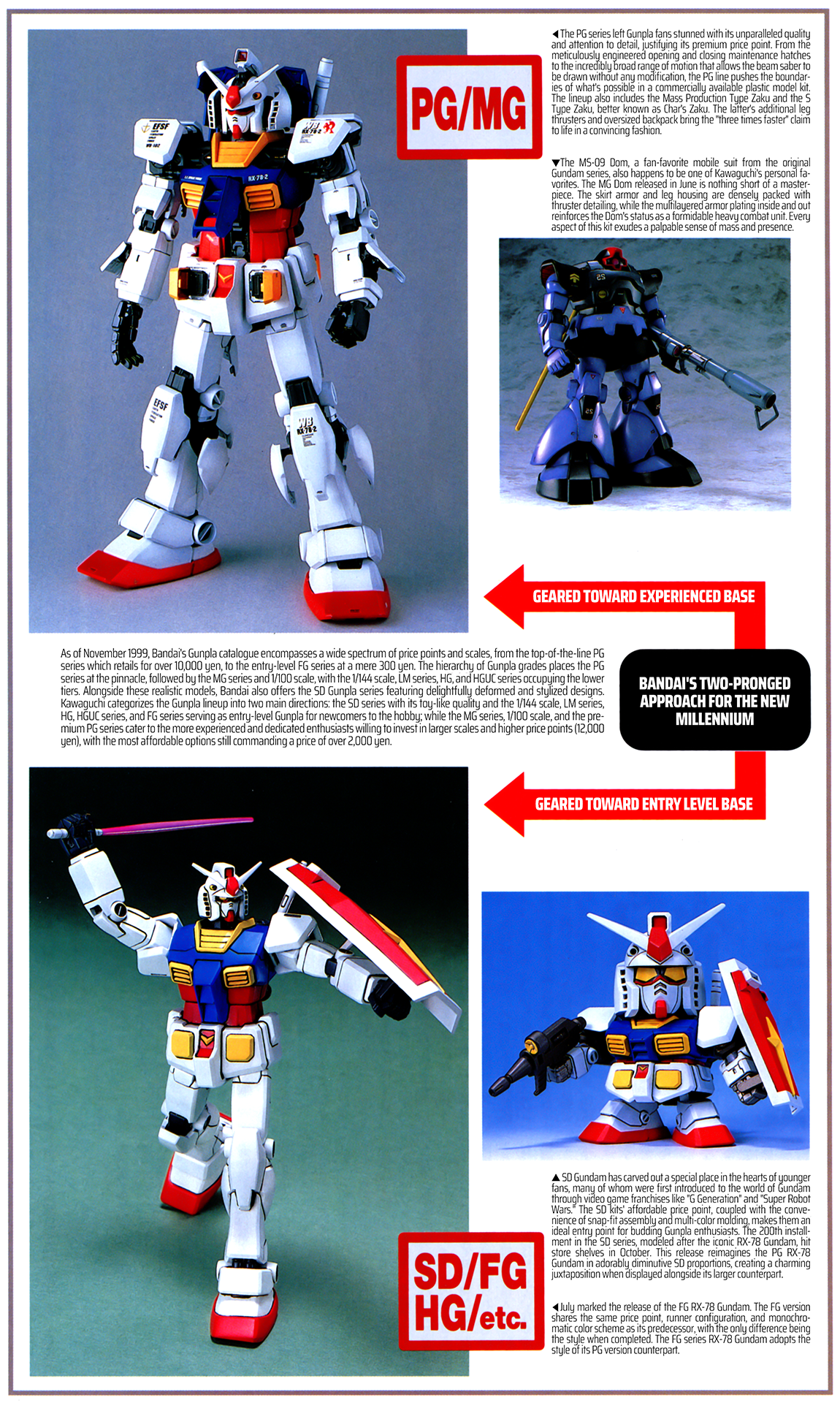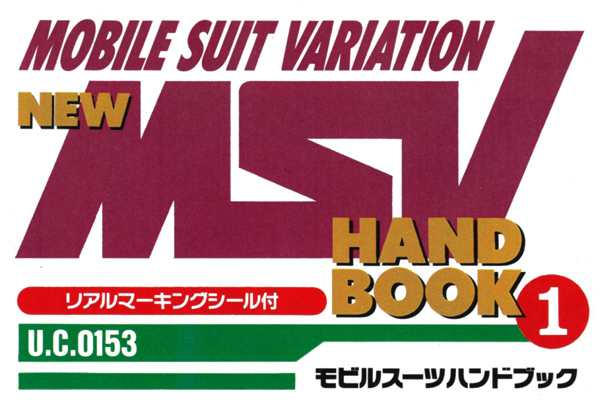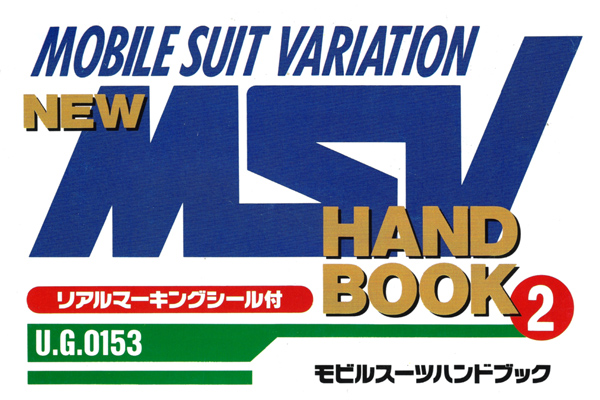GUNDAM BRAND REVIVAL
NOTE: The comments in this article obviously haven’t aged well as they’re from late 1999 in celebration of Gundam’s 20th anniversary. Keep that in mind when reading!
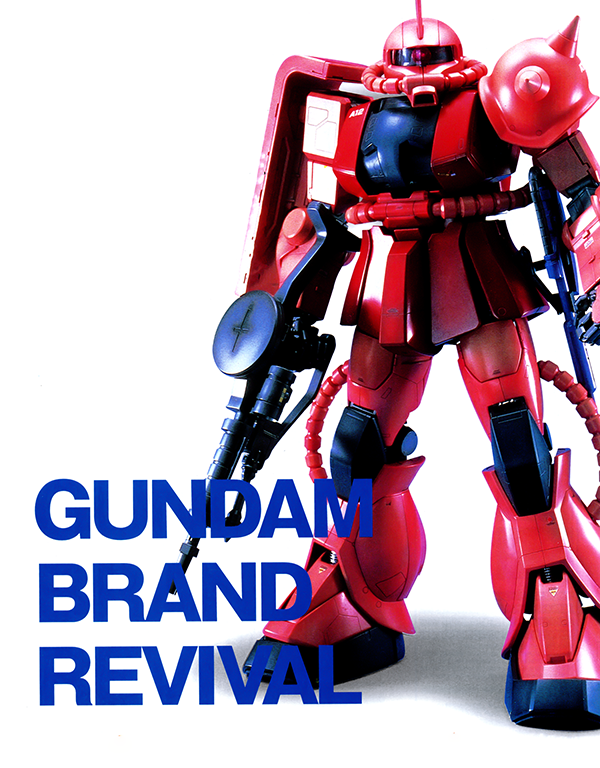
GUNDAM BRAND REVIVAL
The Original Gundams, Reborn in a New Form
The Man Who Revitalized Gunpla with New Technology
Interview with Katsumi Kawaguchi, Bandai Hobby Division
At the heart of the “Gundam culture” that has become as iconic as the anime itself, Gunpla isn’t just about recreating the setting from the series – it’s about adding new interpretations to create even more captivating and dynamic models. Join us as we explore the incredible journey of Gunpla, from its humble beginnings to its exciting present and future.
When Mobile Suit Gundam first hit the airwaves, no one could have predicted the incredible impact it would have on the world of plastic models. The release of Gundam model kits, or “Gunpla,” as character merchandise sparked explosive growth in the plastic model fandom. Back in the days of the First Gundam boom, which kicked off shortly after the original series ended, eager fans would line up at hobby shops every time a new Gunpla hit the shelves.
What made the Gunpla boom so remarkable was its ability to captivate fans of all ages. For younger enthusiasts, it was a gateway into the world of plastic models, which had previously been seen as a hobby for older folks. For the more mature crowd, Gunpla offered a thrilling new outlet for creativity and self-expression in model-building.
Just flip through the pages of old modeling magazines, and you’ll see Gunpla’s undeniable influence. Take Hobby Japan, for example—once Gundam made its debut in the August 1980 issue, the venerable publication, which had previously focused on showcasing tanks and fighter jets from the likes of Tamiya, suddenly found its pages filled with character models like Gunpla.
But as the years went by and fans’ tastes evolved, the once-cutting-edge designs of the past began to feel a bit dated. This was especially true for the First Gundam, which premiered in twenty years ago 1979. Enter Katsumi Kawaguchi, the visionary from Bandai’s Hobby Division who refused to let these classic designs gather dust. Armed with the latest technology and an unwavering passion for Gunpla, Kawaguchi set out to breathe new life into these beloved mecha, updating them for a new generation of fans.
The results speak for themselves – Kawaguchi’s Master Grade (MG) and Perfect Grade (PG) series have given us First Gundam models that look right at home alongside Gunpla from more recent series like Zeta Gundam and Gundam 0083: Stardust Memory.
We sit down with the man himself to discuss his Gundam journey, the groundbreaking techniques he’s used to revitalize classic designs, and his exciting vision for the future of Gunpla.

Katsumi Kawaguchi burst onto the scene as a model magazine writer during the Gunpla boom following the original Gundam anime. His heavily military-influenced Gunpla builds captivated fans. Kawaguchi later joined Bandai, where he now serves as section chief in the Hobby Division’s Development Department, crafting cutting-edge Gunpla like the MG and PG series. The intricacy and weapon-like detailing of the inner mechanics in his MG designs reflect the sensibilities he honed as a writer.
――When the original Gundam series hit the airwaves, you were just wrapping up high school, right? What was your initial reaction to the show?
Kawaguchi: Initially, I was captivated by the characters and the story. As a mecha enthusiast, the concept of mobile suits as these advanced weapons really piqued my interest from a model-making perspective. The only problem was that there weren’t any plamodels on the market back then. So, I had to get creative – I’d take these 1/35 scale figures and kit-bash ’em to make my own custom mobile suits.
I had always been a fan of plastic models, but up until that point, I was primarily focused on military-themed scale models. It just so happened that this other diehard Gundam fan used to hang out at the same model shop as me. That connection actually led to me building a full-scratch build 1/100 Char’s Zaku (using materials like putty and plastic plates to sculpt) for a special “SF Mecha” feature in the August 1981 issue of Hobby Japan magazine. That experience set me on the path to where I am today. For about four and a half years after that, I worked as a writer for publications like Hobby Japan and Comic BomBom.
――Speaking of Comic BomBom, that’s where the renowned MSV series was featured, right? That series played a significant role in expanding the reach and depth of Gundam culture. It fostered an inclusive universe where even mecha that didn’t appear in the anime were embraced and accepted as part of the larger Gundam narrative. In a way, MSV really enriched and developed the worldbuilding of the Gundam universe.
Kawaguchi: That series definitively shaped the methodology and approach to Gunpla construction from that point forward. Now, my personal affinity for military history certainly influenced my perspective, but the core idea was to apply the techniques and principles of military scale modeling to the realm of Gunpla. In retrospect, there were likely other viable approaches, but…
You know, one of the key inspirations behind the MSV series was a green Gundam design sketched by Kunio Okawara, the original mechanical designer for the Gundam series. When I saw that illustration, it was a revelation. I thought to myself, “Oh, so this kind of approach is okay too.” Moreover, many military enthusiasts have a particular fascination with the German army, right? So, there was a natural inclination to draw parallels between the Zeon forces and the Germans. If you think about it, the German army was renowned for developing groundbreaking weapons and tactics that revolutionized warfare. As their war effort began to falter, they turned to increasingly unconventional and experimental weapon prototypes. It’s not dissimilar to the trajectory of Zeon’s mobile suit and mobile armor development and deployment, is it?
――I suppose that explains the military-inspired approach you took in those “HOW TO BUILD GUNDAM” specials for Hobby Japan. I imagine countless modelers learned techniques like weathering and damage detailing from those features.
Kawaguchi: Ah, you’re referring to HOW TO BUILD GUNDAM 2, right? With the first installment, the focus was on recreating specific scenes and moments from the anime. But for the follow-up, we went all-in on the military theme. I came on board to assist Masahiro Oda, a renowned writer in the modeling community. Believe it or not, we were coordinating the color schemes for the example builds over the phone. I pushed myself to the brink to complete everything in time for the final deadline… and as fate would have it, that delivery day coincided with the theatrical premiere of Encounters in Space. It was, without a doubt, the most thrilling and memorable project I worked on during my time as a writer.
In those days, the ultimate goal of military modeling was to achieve the most accurate, scaled-down representation of the real-world subject. If you were truly committed to pushing the boundaries of realism, the accuracy and depth of your reference materials were paramount. It was easy to fall into a mindset of “reference material supremacy,” so to speak. But with Gundam, the anime was essentially the sole “official” reference we had to work with. And that ended up being this incredible canvas for our imaginations to run wild. In a sense, Gunpla became a liberating force for us, freeing us from the creative constraints of traditional scale modeling.
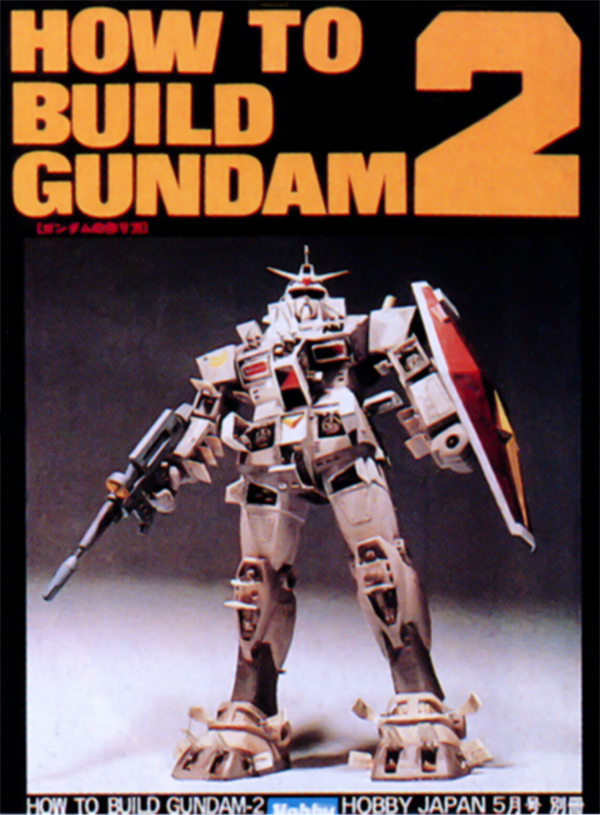
HOW TO BUILD GUNDAM 2, a mook featuring Kawaguchi’s work, was the go-to guide for Gunpla customization at the time. Its pages inspired countless modelers to create detailed mobile suit cutaways and battle dioramas. Many techniques that became industry standards for Gunpla modification originated in this book, solidifying its legacy as a defining force in the hobby’s evolution.
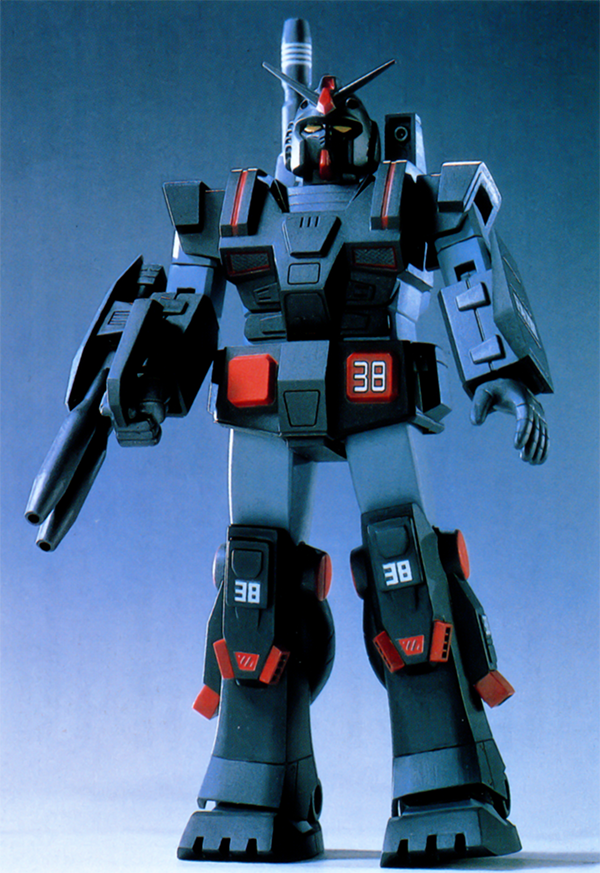
Comic BomBom introduced the groundbreaking MSV series, which made mobile suits absent from the anime an official part of Gundam lore. Bandai later released kits of select MSV designs. By the way, why do I feel like there were many underwater mobile suits, such as Z’Gok and Acguy? MSV paved the way for expansions to the Gundam universe, such as Katoki’s Gundam Sentinel in Model Graphix, broadening the horizon of Gundam culture.
――Let’s go back a bit. When you mention the scale model approach, the details on the MG series Gunpla also have a scale model-like feel, don’t they?
Kawaguchi: Yes, the MG series is created with a scale model mindset. That said, with the early MG series works like the Gundam, Zaku, and Gelgoog, there was also an emphasis on staying true to Okawara’s original design lines. It’s the idea of envisioning how Okawara might have designed these mobile suits if the original Gundam series were airing today.
――Later on, when the Zeta Gundam was added to the MG series lineup, Hajime Katoki stepped in to handle design refinements. What exactly does Katoki bring to the table?
Kawaguchi: We ask Katoki to work in a capacity similar to a 3D animation director. When the Zeta Gundam joined the MG lineup, finding harmony between the transformation mechanics and overall aesthetics proved to be a significant challenge. It brought to mind a discussion I had with Katoki about the V Gundam’s transformation back when the series was on the air. Katoki has a keen eye for surface composition when it comes to Mobile Suit design, so I believed he was uniquely qualified to reconcile the Zeta Gundam’s mobile suit and Wave Rider modes in model kit form. Looking ahead, the MG series had the GP units from Gundam 0083: Stardust Memory and more on the horizon, and I felt Katoki was the ideal choice to oversee the design refinements for the MG series. For recent releases like the Gundam Alex from Gundam 0080: War in the Pocket with its Chobham armor or the additional parts for the Gundam GP Full Vernian, Katoki’s involvement was crucial in realizing the gimmick of layering the extra equipment onto the base Gundam, as depicted in the original settings.
I want to be clear – this is not about the fan-dubbed “Version Katoki” designs that have garnered attention in the community, such as his reimagined mobile suits featured in Newtype and other anime magazines. Bandai has no intention of marketing the MG series under the “Version Katoki” label. I fully recognize that it would be a grave disservice to the original designers, so we make a point to steer clear of that particular approach. The goal for the MG series designs is to pursue the quintessential representation of each mobile suit as of the year it was released – for instance, the ideal Zeta Gundam design circa 1996. Another way to frame it would be “the form these mobile suits would realistically assume if they truly existed, informed by current technology and sensibilities.”
――But doesn’t the very nature of design refinement imply altering the original designs? Couldn’t that give rise to various issues?
Kawaguchi: The interpretation of style and surface composition during the refinement process is carried out under the supervision of Sunrise. However, certain aspects are inevitably influenced by the unique requirements of the plastic model kit medium. Considerations must be made for parts separation to ensure a satisfying build experience for the user, as well as gimmicks related to articulation, transformation, and other features that enhance the play value of the completed model. Katoki’s designs are invaluable because he incorporates ideas that address these factors. Moreover, he takes into account the appropriate design language for each kit’s scale, be it 1/60, 1/100, 1/144, or any other. The scale affects the molds, meaning the engraved panel lines and surface details, the gimmicks that can be integrated, and the internal molds visible through gaps in the armor, such as the nozzles beneath the Dom’s skirt or the piping exposed at the Gundam’s ankles.
――If the currently airing Turn A Gundam were to receive the MG treatment, would Katoki still be tapped for the design refinement?
Kawaguchi: When it comes to Turn A Gundam, the tried-and-true methods simply wouldn’t apply. Syd Mead, the designer behind the Turn A, approaches his work from a three-dimensional perspective from the outset. He possesses a comprehensive mental blueprint of the components that lie beneath that intricately interwoven armor, how they interconnect, and how they function.
Take the beam saber rack on the back of the Turn A Gundam’s shoulder, for instance. I once remarked that with such close proximity to the arm, it would impede the arm’s upward movement. Mead pointed out the slender gap between the beam saber rack and the shoulder, asserting that as long as that space existed, it would pose no issue. Lo and behold, when we actually built it, the arm could indeed articulate without getting caught on the beam saber rack, just as he said.
So, if we were to adapt the Turn A into an MG kit, our sole recourse would be to have Mead exhaustively divulge every morsel of the its design that resides within his mind. If Katoki is someone who “delivers designs that lend themselves to plastic model production and possess a convincing quality,” then Mead could be described as someone who “has every part and every gimmick in his head, and can provide the necessary design elements for animation or other media from that wealth of information.”
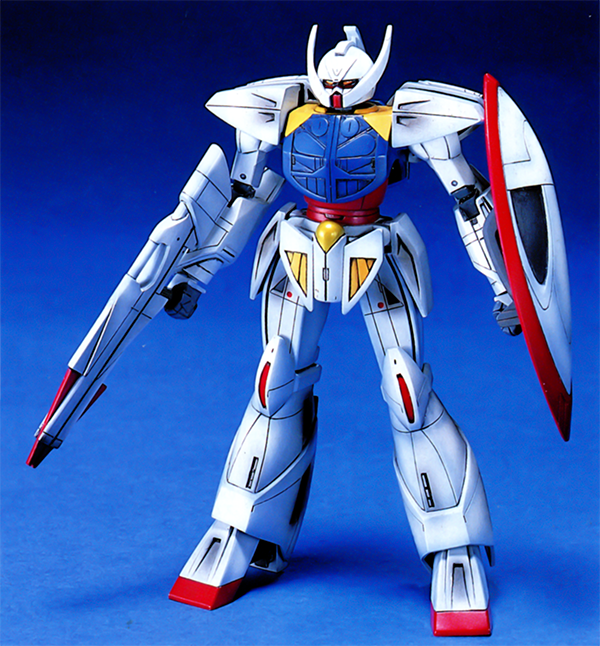
The 1/144 ∀ Gundam kit captures the mobile suit’s unique form with stunning accuracy despite its small size. At just 500 yen (before tax), it’s a must-buy. July saw the release of an even more impressive 1/100 version. While an MG seemed unlikely, both kits exceed expectations in quality.
――Even so, the mobile suits in Turn A Gundam have a drastically different impression compared to earlier series. Wouldn’t translating them into Gunpla present quite the undertaking?
Kawaguchi: We certainly harbored apprehensions about their viability as three-dimensional entities. While not the sole motivating factor, but after seeing Mead’s rough designs, I tried scratch-building a 1/60 scale bust of it, infusing it with a touch of classic Gundam design elements. The resulting bust showcased the iconic Gundam visage nestled betwixt the Turn A Gundam’s signature mustache. I even brought it along to a meeting on one occasion.
Later, following the unveiling of Mead’s finalized designs, I undertook another scratch-building endeavor, this time a 1/100 scale bust from the waist up. That experience quelled any lingering doubts I held about its capacity for three-dimensional realization. Personally, I see Turn A Gundam as a series that exists at the endpoint of the traditional Gundam series continuity. I mean, the nanoskin armor material used on the Turn A Gundam and the mobile suit SUMO, doesn’t that remind you of the DG cells from Mobile Fighter G Gundam (referring to the cells of the Ultimate Gundam, commonly known as the Devil Gundam, which possess the three major abilities of self-regeneration, self-multiplication, and self-evolution – essentially a type of nanomachine with self-replicating abilities)? The world of Turn A Gundam embodies all the hallmarks of the Gundam series, whether latent or explicit.
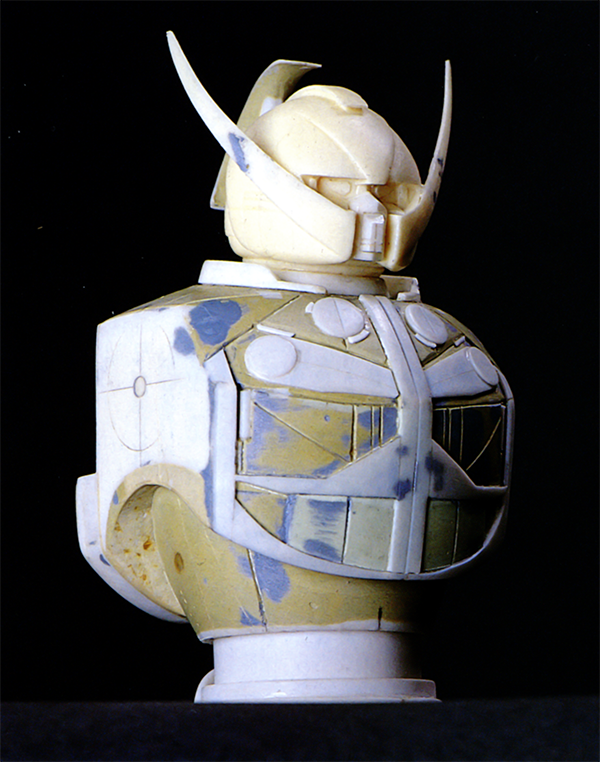
This 1/100 scratch-built ∀ Gundam bust by Kawaguchi dates back to when Syd Mead’s design was nearly finalized. The three-dimensional form highlights the ∀ Gundam’s sculpted elegance. While its face appears flat on-screen, the physical representation accentuates the sweeping curves of its mustache, creating a striking impression. The unpainted bust also showcases the diverse materials used in its construction.
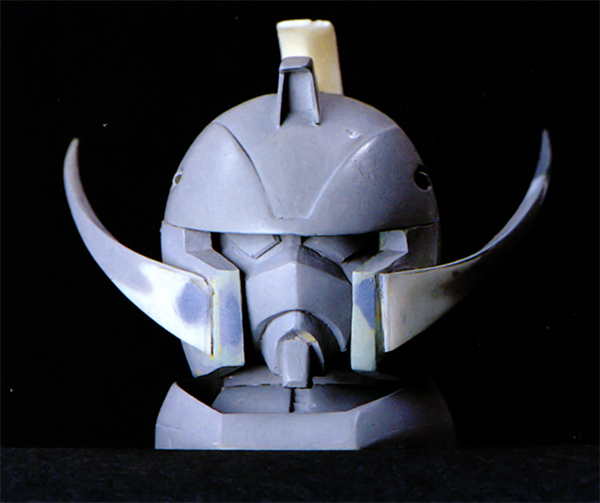
Predating the bust is Kawaguchi’s scratch-built 1/60 ∀ Gundam head. Nestled between the suit’s signature mustache lies a classic Gundam face. The addition of this iconic design element alters the impression dramatically, evoking a traditional Gundam feel. By the way, if you say ∀ Gundam Hyper Mode or something, and the mustache opens up and this face mask appears, it somehow looks strangely cool.
――Surprisingly, even the silhouette of the Turn A Gundam is rather Gundam-esque.
Kawaguchi: While it initially caught everyone off guard, it’s worth noting that Mead himself is by no means oblivious to or incapable of traditional Gundam design sensibilities.
At the very beginning of the Turn A Gundam’s design process, it appears he explored various avenues based on Okawara’s proposed Turn A Gundam concepts. In the lead-up to the current design, he even graced us with designs that harkened back to the original Gundam. So, there’s no way Mead is unfamiliar with the Gundam series.
Even that distinctive mustache traces its origins to the Gundam’s forehead crest. When examining the silhouette, it’s the forehead crest that defines the quintessential Gundam impression. The notion of accentuating that feature seems to have served as the conceptual catalyst.
Of course, when he first presented the current SUMO design and said it was the Turn A Gundam, we were at a bit of a loss. (laughs)
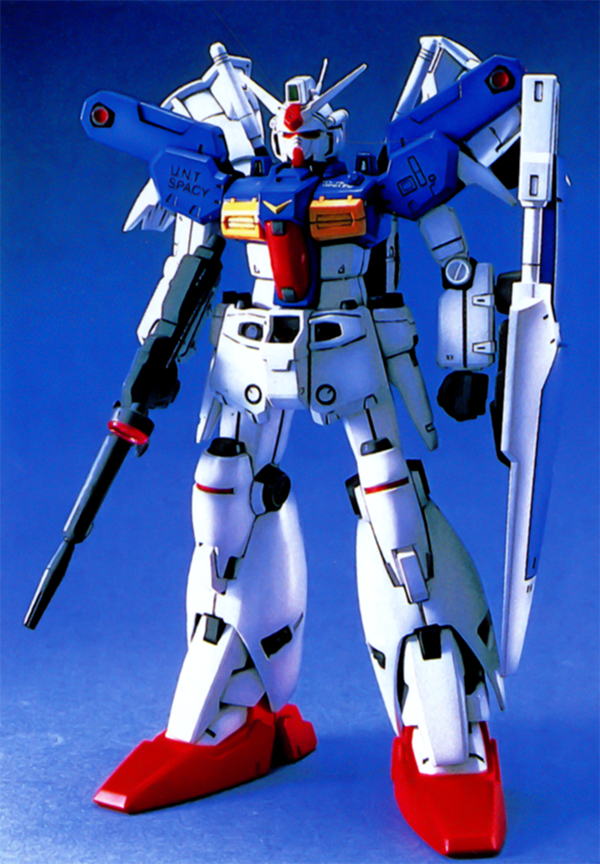
The MG Gundam GP01Fb astonishes with its ability to convert to the ground-use GP01 by swapping a few parts – a testament to its engineering and faithfulness to the source material. Compare it to Katoki’s GP01 redesign from Newtype and you’ll find the MG hews closer to Kawamori’s original OVA version. It represents Katoki’s ideal refinement of the GP01 in model form.

The MG Zeta Gundam, Katoki’s first redesign, stuns in both mobile suit and Wave Rider modes. As one of Gundam’s most beloved mobile suits, its enduring popularity is no surprise. While Bandai’s old 1/100 Zeta was impressive in its own right, particularly for incorporating the transformation option, the MG’s superiority is undeniable. Katoki’s name also evokes his iconic Sentinel designs – perhaps the Z Plus and S Gundam will one day join the MG lineup.
――I’d like to shift gears for a moment and discuss something that’s been on my mind as a Gunpla enthusiast. With the introduction of the MG and PG series, particularly when I witness the intricate inner workings, gimmicks, and detailing of the PG kits, I can’t help but wonder if it’s even possible to surpass what’s already been achieved. This concern has led me to ponder Gunpla’s future direction. What are your thoughts on this matter?
Kawaguchi: The PG series does incorporate basically everything that’s possible with current plastic model technology. However, just as advancements in techniques have continuously propelled the evolution of Gunpla, I wouldn’t go so far as to say this is the be-all and end-all.
Even now, I can envision several potential avenues. For instance, we could explore integrating the technologies developed for the PG series into the MG series, the 500-yen price point series, the existing HG series, or the recently launched HGUC series, which reimagines the mobile suits from the original Gundam series. Furthermore, by embracing new materials, we may unlock previously unattainable forms of expression.
In fact, we’ve already begun releasing the FG series, which essentially takes the gimmicks from the PG series, strips them down, scales them down, and incorporates the design elements into more affordable kits. The inaugural release, the RX-78 Gundam, distills the highly acclaimed form of the PG RX-78 Gundam into a 300-yen kit.
Speaking of new materials, remember the Evangelion series we put out a while back? We couldn’t have made that happen had we relied solely on conventional materials. However, by embedding joints within rubber components and enveloping the entire figure in a rubber suit, we managed to bring those products to fruition. It’s conceivable that similar breakthroughs await Gunpla in the future. That said, the path we inadvertently set forth, positioning Gunpla as scale models, is likely to evolve.
While the MG and PG series are crafted using scale modeling techniques, the younger staff members at the factory who translate Katoki’s design drawings into technical blueprints possess a distinctly different perspective. Our generation typically began by building scale models before venturing into Gunpla. In contrast, for the younger team members currently working on the blueprints, their initial foray into plastic models was through Gunpla itself. Consequently, their understanding of scale modeling techniques diverges from ours. Their notion of scale modeling methodology has been shaped through the lens of Gunpla.
Looking ahead, those who will engage with Gunpla in the present and future will likely mirror the factory’s younger staff, having learned about plastic models through Gunpla. One potential direction could be to reflect the Gunpla “ideal” that resides within this demographic.
Another avenue to consider is Gunpla’s toy aspect.
To be frank, during the era of Mobile Suit V Gundam, Gunpla sales experienced a significant downturn. While V Gundam garnered critical acclaim as an anime series, from a merchandise perspective, it was a precarious situation.
Subsequently, with Mobile Fighter G Gundam, we sought to capture the attention of younger fans. However, initially, even that endeavor struggled to gain traction.
Fortunately, the introduction of Master Asia, also known as Tohou Fuhai (Undefeated of the East), and the protagonist’s mecha, God Gundam, injected a surge of excitement into the series as a whole. It started drawing attention not just from the kids we were initially targeting, but also piqued the interest of adult Gundam fans, leading to a substantial surge in sales. In a sense, G Gundam became the savior of Gunpla. Without it, the very survival of Gunpla might have been in jeopardy.
But that was just a fluke. We can’t rely on coincidences like that going forward, so we grappled with various challenges. What resulted was the realization that adult Gundam fans and child Gundam fans have different expectations and desires when it comes to Gunpla.
Adult Gundam fans, with their greater purchasing power, tend to gravitate towards Gunpla, which emphasizes mechanical realism and intricate gimmicks. This line of thinking gave birth to the MG and PG series. On the other hand, child Gundam fans face limitations in terms of budget and model-building skills. Moreover, their familiarity with Gundam often stems from the SD style prevalent in games and other media, leading to a preference for more toy-like products. The SD Gundam series and the 1/144 scale 500-yen series are poised to become the core offerings for the younger demographic.
As we step into the 21st century, Gunpla is likely to diverge into these two primary directions.
――In other words, we have the high-end group, exemplified by the MG and PG series, which reflect the sensibilities of the current generation, and the low-end group, which emphasizes character-driven appeal through the SD series and affordable scale models that prioritize design realism. Given these trajectories, where does Turn A Gundam fit into the equation?
Kawaguchi: Turn A Gundam is fundamentally geared towards the high-end group, targeting an adult audience. This aligns with director Tomino’s own assertion that the series is intended for mature viewers from the outset.
――Speaking of the high-end group, with the release of the new MG Dom, the pool of mobile suits yet to be featured seems to be dwindling. What kind of lineup can we expect in the near future? Will you be delving into series like The 08th MS Team, which hasn’t gotten the MG/PG treatment yet? Or are you considering the next installment in the Gundam franchise that will follow Turn A Gundam?
Kawaguchi: As Bandai, we certainly express our desire for Sunrise to create new Gundam series, but we refrain from dictating the specifics of what kind of Gundam they should produce. In the past, it was common for sponsor manufacturers to approach production companies with requests for specific types of anime based on the toys they intended to sell. However, since Evangelion, we at Bandai’s Hobby Division have come to recognize that the work itself should come first, and our expertise lies in figuring out how to transform the designs that best suit the series into merchandise.
This applies not only to Gunpla but to the plastic models Bandai releases as a whole. If an anime is compelling and captivating, we’ll do our best to make kits from it. Good anime is what keeps the plastic model business going.
If we narrow our focus to the Gundam domain, this may sound like a pipe dream, but I’ve always harbored the desire to create a real Gundam someday.
With the PG series and such, we replicate the internal structures, but if I’m being totally honest, they are merely cosmetic imitations. After all, they don’t possess the functionality depicted in the designs, right? A while back, Sony released the “AIBO” robotic pet dog. While it may not be an actual dog, it’s genuine in its own right, wouldn’t you say?
I’d love to someday build a real mobile suit – a Gundam with all the actual mechanisms it would need to function.
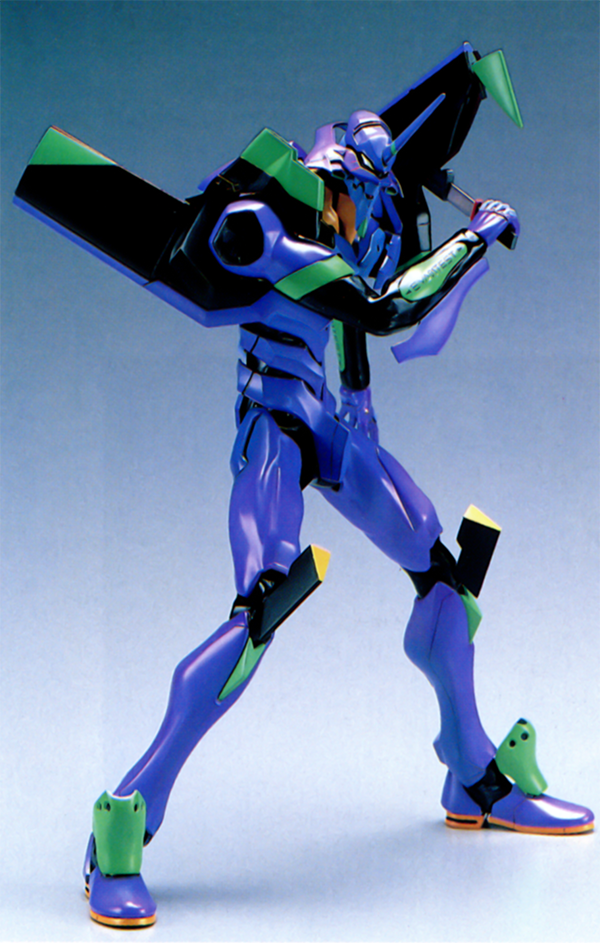
Bandai’s PG Evangelion Unit-01 marked a turning point in the company’s model kit development. With garage kits rivaling the big brands in quality and the safety challenges posed by Eva’s angular design, Bandai’s entry seemed unlikely. Yet they defied expectations, ushering in a new era of unprecedented quality for their kits.
Hearing Kawaguchi talk about wanting to make a real Gundam reminds me of something. The person behind Sony’s Aibo said that what they really wanted to build was Astro Boy.
Although Japan may lag behind the United States and Europe in the realm of cutting-edge technology, it’s worth noting that it was Honda Motor Company that succeeded in developing a bipedal robot. Surprisingly, it wouldn’t be far-fetched to imagine Japan being the first in the world to successfully develop a practical, rideable bipedal robot.
When you think about it that way, the impact that anime has is really incredible.
For all we know, researchers who grew up on Space Battleship Yamato could be designing wave-motion engine-powered space battleships at NASDA right now. Engineers at Mitsubishi Heavy Industries who love Macross might be trying to make transforming fighter jets. And maybe someday, people who grew up watching Evangelion might venture into the realm of genetic engineering to create artificially engineered humans as decisive weapons.
And who knows, in the not-too-distant future, we may witness a day when building a 1/1 scale, fully functional Gundam model in one’s backyard becomes a reality. Admittedly, at this point, we’re venturing into the realm of “Doraemon,” but I digress.
But anyway, as Gundam gets ready to cross over into a new century, we’ve taken a look at the history of its model kits, where things stand now, and where they might be headed. And as I’m sure you can tell, it hasn’t been a smooth road.
After the first Gunpla boom, these model kits managed to appeal to everyone, from their core younger audience to older fans, by introducing real-scale modeling techniques. But that popularity eventually started to fade until the SD Gundam craze and Mobile Fighter G Gundam brought it back. To get older fans interested again, the MG series made its debut, kicking off Gunpla’s second wave.
While we haven’t specifically touched upon it here, the technological advancements during this period have been remarkable. During the initial Gunpla boom, plastic models required adhesive for assembly, and the molded colors were limited to a single hue. Fast forward to the present, and we have snap-fit models that eliminate the need for glue, alongside multi-color molding that renders painting unnecessary.
If you want to see just how far Gunpla has come, I encourage you to place the first-generation 1/144 scale RX-78 Gundam alongside the recently released FG series RX-78 Gundam this July. You’ll really see the difference those 20 years made.



